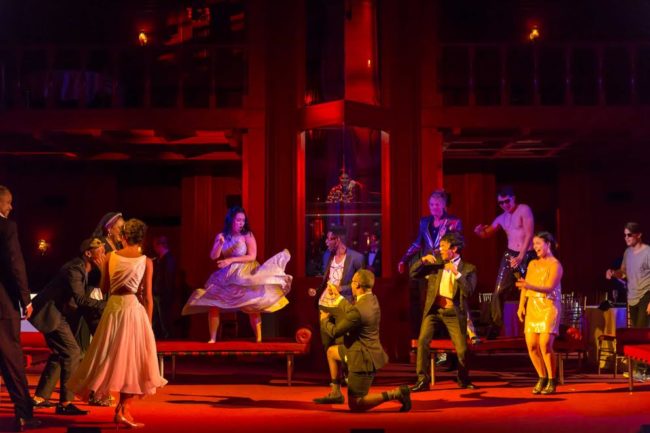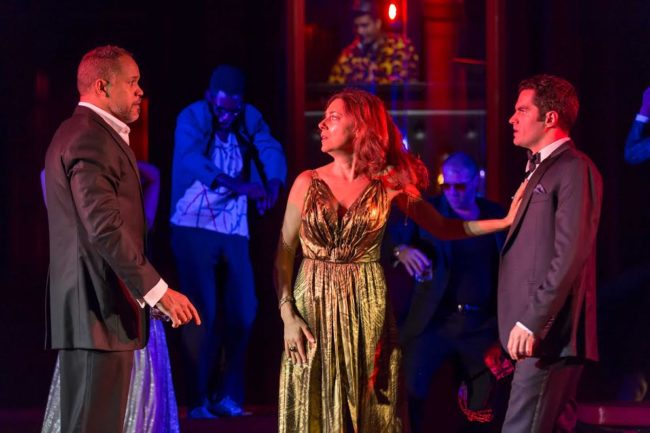Men’s eyes were made to look and let them gaze upon the riveting new production of Romeo & Juliet at Shakespeare Theatre Company. Directed by Alan Paul, this revitalized and somewhat modern approach to the Bard’s most woeful tragedy attends the fates gaily and with swift justice for both the poetic nature of the text and the emotional capacity of the plot. Perilously little can be ascribed in complaint, save for the missed opportunities to push the conceptualized vision on the whole in a slightly different direction, thus rendering it a perfectly impressive representation of the company’s ability to perform the classics and do so well in a praiseworthy manner.

To comment quickly on the missed potential, the initial opening to the production— what with the gorgeously glaring Cherrywood and rouge interior and mafia-inspired 70’s couture— feels only out place for a quick moment. It feels as if Director Alan Paul and the creative team could have pushed the production to in fact be set in a 1970’s Italian night club, though this illusion is quickly shattered when Romeo enters plugged into his smart phone and Benvolio in the same scene checks his digital watch. This momentary disconnect aside, which almost wouldn’t be worth mentioning if the fight-club scene that opens the show didn’t so heavily guide the production in that direction, is the only notable flaw with the performance.
As mentioned Scenic Designer Dane Laffrey fabricates an intriguing two-story interior that is steeped in shades of cherry with undertones of mahogany, wine, and garnet. This deliberate palette of color reflects both the ardent flames of passion between the titular characters as well as the gruesome gore that will besmirch them and their kinsmen before the two hours’ traffic of the stage concludes. The structural concept of the show is impressive in both its stature and presence; this too serves as a reminder for the grandiose nature of how overblown simple things can grow to be in the Bard’s most notorious tragedy. Laffrey lays the ground work for Alan Paul’s brilliant vision to unfold and praises could not be higher for this design work.
Playing as an omnipresent deity that ubiquitously permeates the production, illumination becomes an unspoken character in this production compliments of Lighting Designer Jen Schriever. The way in which light strikes the set, brightening and darkening those rich red hues Laffrey has so carefully crafted into the woodwork is something magnificent, which inspires a multitude of emotions in various scenes. It is Schriever’s intricate approach to the lighting which captures so many of the unexplored moments in Romeo & Juliet that Alan Paul has worked exceptionally hard to include in this production. Painting scenic pictures and striking still-life captures of living actors, Schriever calls attention to this nuggets of nuance, which enhances the viewing experience exponentially. The most stunning of which is Lady Capulet (Judith Lightfoot Clarke) sinking down against the wall and dissolving into her lap after the infamous disowning scene between her husband and her daughter.

Shakespeare Theatre Company’s production of Romeo & Juliet, directed by Alan Paul. Scott Suchman
Where there is light, be it the east or Juliet, there is sound. Composer and Designer Daniel Kluger infuses the production with a heaping helping of this aural enchantment. The house-electronic music which permeates the dinner party— among other— scenes gives the production footing in its modern day setting. Combined with Schriever’s lighting and Laffrey’s set, the atmosphere cultivated is one that well suits the visionary outlay of the director’s approach to the piece. Like a pulsating undercurrent that wends its way into the show, Kluger’s aural intricacies read almost like an undiscovered murmur, beating through Shakespeare’s natural rhythm and surging the production forward.
Working with Fight Choreographer David Leong, Director Eric Tucker captures an explosive essence of violence among the Montagues and Capulets in the production with the opening scenic brawl being nothing short of cacophonous chaos in splendid motion. Tucker’s propensity toward gore brings a good deal of blood into the production while Leong ensures that the punches, jabs, and swings are tight and realistic. These brutal brawls are invigorating and agitate the blood as well as heighten the sense of danger that trails through this unending feud between these two noble families.
Tucker rewards the audience with this newly imagined Romeo & Juliet not by spinning the concept on its head but by broadening the scope through which we see the play. Rather than focusing succinctly on the titular characters, Tucker approaches the script with inclusion of all the surrounding characters, allowing them to live and breathe fully in this world of discord and dismay. There are dozens of little moments that flicker in and out of the production that can easily become a favorite if only they are spotted. Never detracting from what’s occurring directly with Romeo or Juliet and their ill-fated match, these breaths of nuance support their plot and in fact showcase the bigger picture that Shakespeare so deftly penned some 400 years ago.
Making a bold statement to have Peter (Shravan Amin) deliver the prologue, Tucker immediately sets the play’s context on a level of the layman. Dressed as hotel janitor or household servant, Amin almost freestyles his delivery and keeps this attitude throughout his portrayal of the character in service to the house of Capulet. This is but one of many notable performances featured in kind throughout the production. Benvolio (Jimmie “J.J.” Jeter) is of a similarly modern existence, having humorous moments of ‘callout’ and ‘hollerback’ when it comes to his interactions with and around Romeo.
With striking prowess in his delivery of Prince Escalus, James Konicek demands and receives silence and respect whenever his character storms onto the scene. There is a heady masculinity which dominates the authority with which he barks out orders for peace and an unwavering resolution behind his command of presence, both mindful and alive, that draws the eye and ear to the Prince during his brief interactions among the Veronese citizens. Not unlike the wildly abrasive Nurse (Inga Ballard), Konicek’s portrayal goes above and beyond what is often expected of the character. Ballard, who is saucy and irreverent yet delicately poised upon the precipice of realism in her portrayal of the Nurse, reveals new humors in the character and works tired moments of her interactions with Juliet into vivacious excitement. Weighing the solemnity of her character against the silliness of the Nurse, Ballard succeeds in giving her a swift kick in the personality, a feat which keeps everyone amused and engaged with her approach.

When it comes to stirring dull, listless characters into a frenzy, Ron Menzel slays the arduous dragon at hand when it comes to his portrayal of Friar Laurence. Menzel is all but frothing at the mouth with rage and emotion, passion and contention, whenever he’s required to confront Romeo in his various states of delirious doom and moping misery. Delivering the good Friar with ferocious intensity, Menzel blasts wide open the often dismissive piety of the character and makes him a man worthy of the heart-wrenching confession of blame delivered in the play’s final scene.
Feeding into the veins of modernity, Mercutio (Jeffrey Carlson) pumps afresh a disorderly fellow that lives in his own abstract world of rock and roll, both in look and intention. Carlson, whose outfit not only screams Billy Idol crossbred with David Bowie but essentially solidifies this imagery for the audience, carries the character with an off-handed physicality that makes him salacious, savory, and succulent, a true morsel to delight in, which makes his character’s untimely demise all the more devastating. Carlson affects his patois in such a way that defies clear description but will have you hanging upon every word, especially those delivered in the ridiculous Queen Mab monologue. Approaching that speech with a kernel of truth that is clear only to himself, Carlson masterfully translates the nonsense into compassionate and compelling emotion making it one of the more astonishing speeches delivered in the performance. The fight scene between he and Tybalt (Alex Mickiewicz, who bends the character with an unfathomable rage which is perpetually erupting from every visage possible on his person) is stellar in its execution, paving the way for a disarming string of final words uttered from Carlson’s lips at the end of the first act.
Laden heavy with the dreadful burdens of being a teenager in love, Romeo (Andrew Veenstra) is the typical embodiment of a moody adolescent who understands little more beyond the realm of what his own eyes can see. Veenstra takes this weary characterization and mines it theatrically, resulting in a curious exploration of Romeo that is more ardent and less whiny that the Bard has him penned. The infamous balcony scene with Juliet (Ayana Workman)— which for the first three quarters is played out on the ground— is portrayed in such a way that Romeo’s exasperation is felt keenly. The conflagration of passion which sparks quickly between the pair is a powder keg of experiences that intensifies every time they are close to one another.

Workman, who takes the latter half of the show’s titular roles, delivers an astonishing depth to the young Juliet. Unafraid to expose the strength that Shakespeare has crafted in Juliet, Workman portrays her in a way that is both true to her teenage inexperience and yet speaks volumes of her emotional capacity. Willful and possessed of spirit that is unbreakable regardless of the County Paris (Gregory Wooddell) or her stubborn and obstinate father, Lord Capulet (Keith Hamilton Cobb) and their ideals for her life. Tremendously present and equally mindful of the passionate embraces shared with Veenstra, Workman is well suited for the role of Juliet.
A perfect restaging and retelling and refocusing of this timeless classic has landed itself for a bit more than two hours’ traffic upon the stage of The Shakespeare Theatre Company. It is not one to be missed this season.
Running Time: 2 hours and 35 minutes with one intermission
Romeo & Juliet plays through November 6, 2016 at Shakespeare Theatre Company in the Lansburgh Theatre— 450 7th Street NW in the Penn Quarter—China Town neighborhood of Washington DC. For tickets call the box office at (20) 547-1122 or purchase them online.

